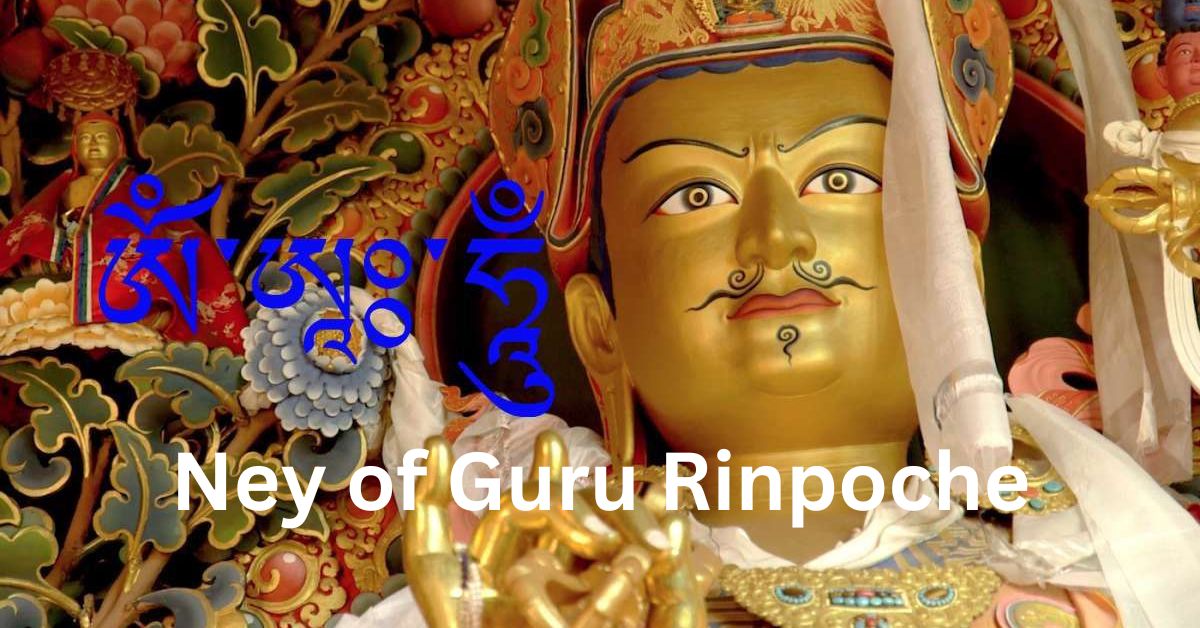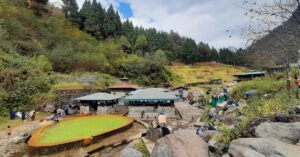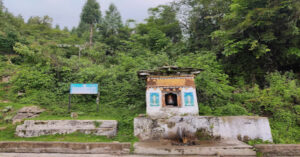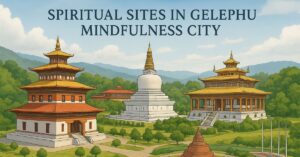“Om Ah Hung” Ney are the three sites blessed by Guru Rinpoche in the 8th century and considered the holiest since their names begin with the letters, Om, Ah, and Hung, which form the Buddhist Mantra, “Om Ah Hung”. They are Omba Ney in Trashi Yangtse, Aja Ney in Monggar, and Hungrel Ney in Paro.
Omba Ney is the first of three sacred sites connected to Guru Rimpoche, with the second being Aja Ney and the third Hungrel Ney. We can see the letter “Om” at Omba Ney, a hundred inscriptions of “Ah”, and the letter “Hung” at Hungrel Ney. The pilgrims make it a point to visit these sites at least once in chronological order.
The Om Ah Hung Ney of Guru Rinpoche are:
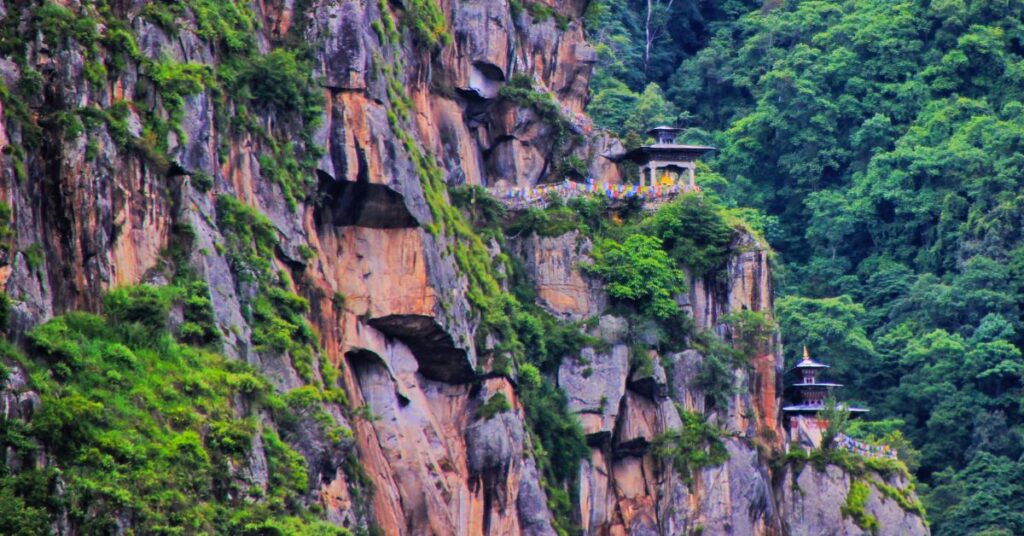
1. Omba Ney, the “Taktsang of Eastern Bhutan, where Letter OM is seen”
Omba Ney is the first of Guru Rinpoche’s three holiest sites that form part of “Om Ah Hung” Ney. This Ney in Trashiyangtse is known as the “Taktsang of Eastern Bhutan,” and is considered the equivalent of visiting the Taktsang monastery by the people of eastern Bhutan. The Ney is situated on a cliff at an altitude of 2200m, about 3 hours from Nangkhar Goenpa.
Many imprints left by Guru Rinpoche can be seen as you ascend to the top of the Ney. Guru Rinpoche is said to have personally blessed temples, caves, and artifacts. It is said that if one can crawl through a narrow cave passage on the cliff above the Temple, one can cleanse one’s defilement. The holy pilgrim site’s main attraction is the letter Om on the rock face, which is thought to have appeared naturally.
You can visit all year because the area is one of the driest in the region. There is a homestay for your wonderful trekking memories. If you’re looking for the perfect time to travel, the best months to visit are March and April.
Read More: Omba Ney, the “Taktsang of Eastern Bhutan, where Letter OM is seen”

2. Aja Ney, a sacred site of a hundred inscriptions of the syllable ‘Aa’
Aja Ney is a sacred, hidden place and the second of the three holiest sites of Guru Rinpoche that form part of “Om Ah Hung” Ney. This sacred site is in the Ngatsang village in Eastern Bhutan at 3,500 meters above sea level. Pilgrims would take 2 days to Aja Ney from Serzhong, the nearest road point, at normal walking speed. It would take a week to complete the Aja Ney pilgrimage.
Guru Rinpoche meditated at Aja Ney for three months, waiting for the appropriate opportunity to subjugate Khikha-Rathoed, who was exiled into an isolated deep forest from Tibet. Terton Ugyen Lingpa was the first to unlock the sacred site of Aja Ney in the 14th century, followed by Terton Rigzin Goeki Dhemthrug.
Also Read: Guru Rinpoche in Bhutan: His Visits to Bhutan and Sacred Sites
The most popular site of the Ney is a cave on the bank of Aja Chhu where Guru Rinpoche meditated for three months to subdue the Tibetan demon, King, Khikha-rathoed. Guru Rinpoche is claimed to have imprinted one hundred repetitions of the sacred syllable “Aa” on the cave’s inner walls after completing his meditation to commemorate the attainment of perfection. Thus, the name ‘Aja’ translates to the hundred syllables of “Aa.”
So, Aja Ney roughly means a sacred site of a hundred inscriptions of the syllable ‘Aa.’ The pilgrims are said to experience a brief insight when they see the 100 inscriptions and are believed to be cleansed of their previous misdeeds.
The best season to visit Aja Ney is between April and October, but avoid the monsoon season.
Read More: Aja Ney, a sacred site of a hundred inscriptions of the syllable ‘Aa’
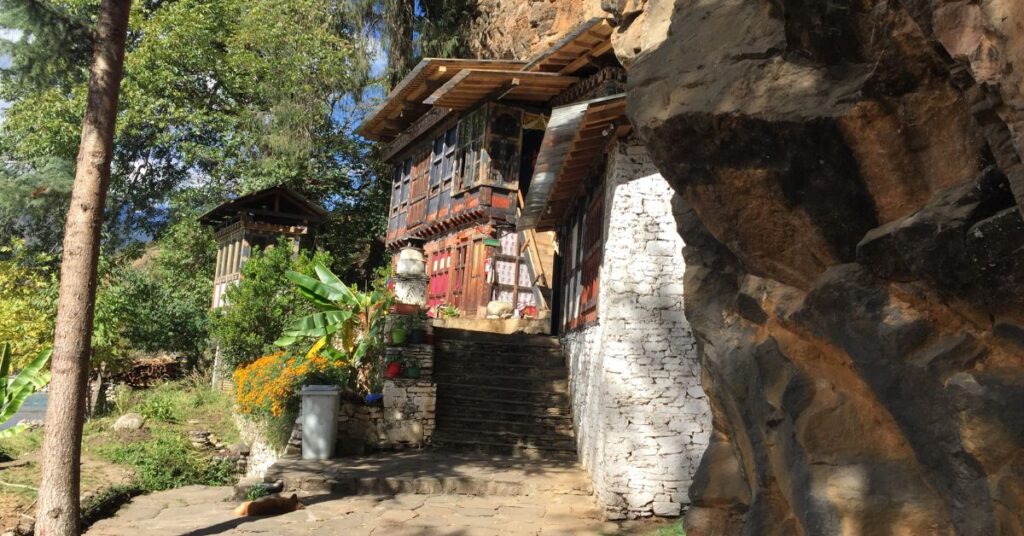
3. Hungrel Ne, a Sacred Site where the word “Hung,” of the Buddhist Mantra, “Om Ah Hung,” can be seen
Hungrel Ney is the third and the last of Guru Rinpoche’s three holiest sites that form part of “Om Ah Hung” Ney. The Hungrel Ney is located just below the present-day Paro Rinpung Dzong, known as the Paro Dzong. The Dzong was built by Drung Drung Gyelchog in the 15th century.
The historical site has a Goenkhang of Bjawog Nyap or Jowo Nep (Hungrel Goenpo). This Lhakhang is built against the Hungrel drag (cliff) and hosts Guru Sungjoenma as the main relic. And just below the Goenkhang are two holy waters (Drubchhu): Jowo Drubchhu and Hungrel Drubchhu. These Drubchhus are believed to cleanse all our impurities (drip).
Also Read: Drupchhu or Holy Spring Waters in Bhutan: Beliefs and Benefits
The sacred word “Hung” can still be seen at Hungrel Ney. There is no best time to visit Paro Dzong. You can visit at any time of the season. However, if you want to see the grand event at the Dzong, we recommend visiting the Dzong during the festive season. The festival season is from the 11th to the 15th day of the second month of the Bhutanese calendar, where the Rinpung Dzong hosts a grand annual festival known as Tshechu (usually in March or April of the Gregorian calendar).
Read More: Hungrel Ney, a Sacred Site where the word “Hung,” of the Buddhist Mantra, “Om Ah Hung,” can be seen
Conclusion
Om Ah Hung Ney are three sacred sites in Trashi Yangtse, Monggar, and Paro, blessed by Guru Padmasambhava in the 8th century. Named after the Buddhist Mantra “Om Ah Hung”, they feature the letters Om, Ah, and Hung, with Omba Ney being the first, Aja Ney the second, and Hungrel Dzong the third. Pilgrims visit these sites in chronological order. You can visit these sacred sites of Bhutan with the Bhutan Pilgrimage Package.
Enjoyed reading this blog?

